Transylvania is a historical region in present-day Romania.
Contents
Transylvania may also refer to:
Transylvania is a historical region in present-day Romania.
Transylvania may also refer to:
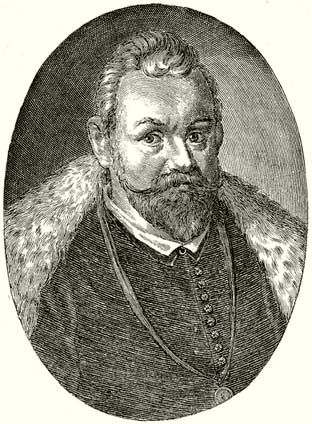
Christopher Báthory was voivode of Transylvania from 1576 to 1581. He was a younger son of Stephen Báthory of Somlyó. Christopher's career began during the reign of Queen Isabella Jagiellon, who administered the eastern territories of the Kingdom of Hungary on behalf of her son, John Sigismund Zápolya, from 1556 to 1559. He was one of the commanders of John Sigismund's army in the early 1560s.
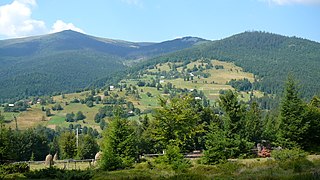
Transylvania is a historical and cultural region in Central and Eastern Europe, encompassing central Romania. To the east and south its natural border is the Carpathian Mountains and to the west the Apuseni Mountains. Broader definitions of Transylvania also include the western and northwestern Romanian regions of Crișana and Maramureș, and occasionally Banat. Historical Transylvania also includes small parts of neighbouring Western Moldavia and even a small part of south-western neighbouring Bukovina to its north east. The capital of the region is Cluj-Napoca.

Brașov is a city in Transylvania, Romania and the county seat of Brașov County.

Deva is a city in Romania, in the historical region of Transylvania, on the left bank of the river Mureș. It is the capital of Hunedoara County.
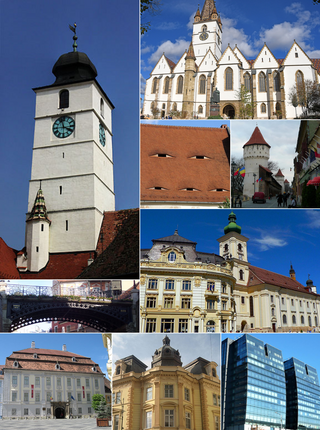
Sibiu is a middle-sized, well-preserved fortified medieval town in central Romania, situated in the historical region of Transylvania. Located some 275 km (171 mi) north-west of Bucharest, the town straddles the Cibin River, a tributary of the river Olt. Now the county seat of the Sibiu County, between 1692 and 1791 and 1849–65 Sibiu was the capital of the Principality of Transylvania. During the Modern era, the Hecht hause in Sibiu served as the seat of the Transylvanian Saxon University.
Largely as a result of the success of Bram Stoker's Dracula, Transylvania has become a popular setting for gothic horror fiction, and most particularly vampire fiction. In some later books and movies Stoker's Count Dracula was conflated with the historical Vlad III Dracula, known as Vlad the Impaler (1431–1476), who though most likely born in the Transylvanian city of Sighișoara, ruled over neighboring Wallachia.

Făgăraș is a city in central Romania, located in Brașov County. It lies on the Olt River and has a population of 28,330 as of 2011. It is situated in the historical region of Transylvania, and is the main city of a subregion, Țara Făgărașului.

The Transylvanian Saxons are a people of mainly German ethnicity and overall Germanic origin; mostly Luxembourgish initially during the medieval Ostsiedlung process, then also from other parts of present-day Germany) who settled in Transylvania in various waves, starting from the mid and mid-late 12th century until the mid 19th century.
The Prince of Transylvania was the head of state of the Principality of Transylvania from the last decades of the 16th century until the middle of the 18th century. John Sigismund Zápolya was the first to adopt the title in 1570, but its use only became stable from 1576.
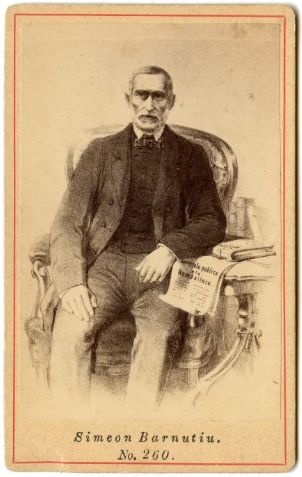
Simion Bărnuțiu was a Transylvanian, later Romanian historian, academic, philosopher, jurist, and liberal politician. A leader of the 1848 revolutionary movement of Transylvanian Romanians, he represented its Eastern Rite Catholic wing. Bărnuțiu lived for a large part of his life in Moldavia, and was for long a professor of philosophy at Academia Mihăileană and at the University of Iași.

The Germans of Romania represent one of the most significant historical ethnic minorities of Romania.

George Bariț, was an ethnic Romanian Austro-Hungarian historian, philologist, playwright, politician, businessman and journalist, the founder of the Romanian language press in Transylvania.
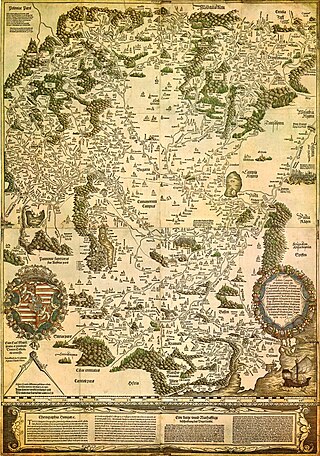
Transylvania is a historical region in central and northwestern Romania. It was under the rule of the Agathyrsi, part of the Dacian Kingdom, Roman Dacia (106–271), the Goths, the Hunnic Empire, the Kingdom of the Gepids, the Avar Khaganate, the Slavs, and the 9th century First Bulgarian Empire. During the late 9th century, Transylvania was reached and conquered by the Hungarian conquerors, and Gyula's family from seven chieftains of the Hungarians ruled Transylvania in the 10th century. King Stephen I of Hungary asserted his claim to rule all lands dominated by Hungarian lords, and he personally led his army against his maternal uncle Gyula III. Transylvania became part of the Kingdom of Hungary in 1002, and it belonged to the Lands of the Hungarian Crown until 1920.

The flag and coat of arms of Transylvania were granted by Maria Theresa in 1765, when she established a Grand Principality within the Habsburg monarchy. While neither symbol has official status in present-day Romania, the coat of arms is marshalled within the national Romanian arms; it was also for decades a component of the Hungarian arms. In its upper half, it prominently includes the eagle, which may have been one of the oldest regional symbols, or is otherwise a localized version of the Polish eagle. Early versions of the Transylvanian charges were first designed in Habsburg Hungary at some point before 1550, and were therefore symbols of pretence.

The Principality of Transylvania was a semi-independent state ruled primarily by Hungarian princes. Its territory, in addition to the traditional Transylvanian lands, also included the other major component called Partium, which was in some periods comparable in size with Transylvania proper. The establishment of the principality was connected to the Treaty of Speyer. However, Stephen Báthory's status as king of Poland also helped to phase in the name Principality of Transylvania. It was usually under the suzerainty of the Ottoman Empire, although the principality often had dual vassalage in the 16th and 17th centuries.
Moses Székely was Prince of Transylvania in 1603.

The Principality of Transylvania, from 1765 the Grand Principality of Transylvania, was a realm of the Hungarian Crown and from 1804 an Austrian crownland ruled by the Habsburg and Habsburg-Lorraine monarchs of the Habsburg monarchy. After the Ottomans were ousted from most of the territories of medieval Kingdom of Hungary, and after the failure of Rákóczi's War of Independence (1703-1711), the Habsburg dynasty claimed the former territories of the Principality of Transylvania under the capacity of their title of "King of Hungary". During the Hungarian Revolution of 1848, the Hungarian government proclaimed union with Transylvania in the April Laws of 1848. After the failure of the revolution, the March Constitution of Austria decreed that the Principality of Transylvania be a separate crown land entirely independent of Hungary. In 1867, as a result of the Austro-Hungarian Compromise, the principality was reunited with Hungary proper.
Transylvanian may refer to:
Gheorghe of Sîngeorgiu, also known as Gheorghe of Sângeorz, was the Reformed bishop of the Transylvanian Romanians from 1566 to around 1568.
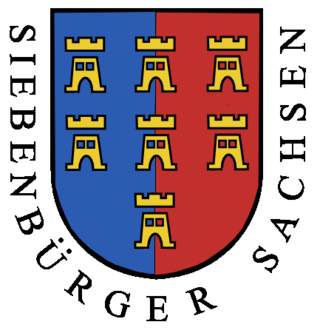
The Transylvanian Saxon University was an official governing body of the Transylvanian Saxon community in Transylvania during the Late Middle Ages up until the late Modern Age. The Saxon University was led by the Saxon Count.